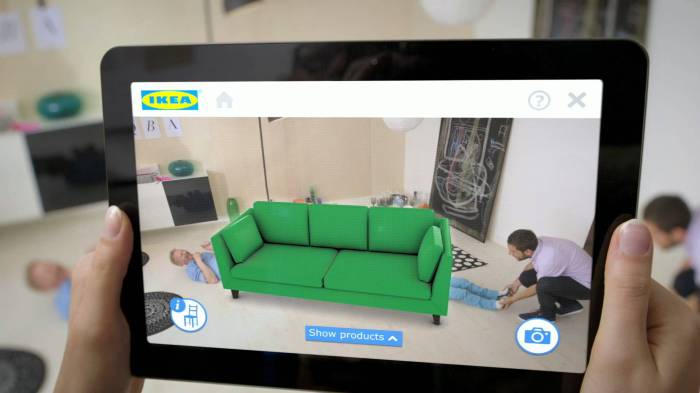
Augmented reality shopping is revolutionizing the way we interact with real estate, offering dynamic and immersive experiences that enhance property viewings like never before. Imagine walking through a home without stepping foot inside, visualizing your dream renovations, or arranging furniture in real-time—all thanks to AR technology.
This innovative approach not only captivates potential buyers but also streamlines the home buying process, making it more engaging and efficient. As we delve into the applications and future of augmented reality in real estate, we’ll uncover the transformative impact this technology is having on how properties are marketed and sold.
Augmented Reality Shopping in Real Estate
Augmented reality (AR) is revolutionizing the real estate industry by providing potential buyers with immersive and interactive property viewing experiences. With AR, clients can visualize properties in a way that goes beyond traditional methods, making the process of buying a home more engaging and informed.AR enhances property viewings by allowing potential buyers to explore homes virtually, eliminating geographical barriers and significantly reducing the time spent on physical site visits.
Through AR applications, users can walk through a property from their own space, experiencing a 360-degree view of each room as if they are physically present. This technology also enables overlaying information about the property—like dimensions, features, and even history—directly onto the live view of the space, thus enriching the buying experience.
Benefits of Augmented Reality for Home Renovations and Decorations
When it comes to visualizing home renovations, AR provides an invaluable tool for buyers and homeowners alike. This technology allows users to see potential changes in real-time, helping them to make more informed decisions about their investments. The following points highlight the benefits of using AR for home renovation and decoration projects:
- Realistic Visualization: Users can see how different colors, materials, and furniture arrangements will look within their actual space, allowing for better decision-making.
- Cost Efficiency: By visualizing renovations before they happen, buyers can avoid costly mistakes and make more accurate budget allocations.
- Enhanced Creativity: AR tools often include design elements and templates, inspiring homeowners to explore creative solutions for their spaces.
- Increased Engagement: Interactive AR experiences help users feel more connected to their potential homes, enhancing their emotional investment in the property.
Integration of AR Technology in Real Estate Listings
The integration of AR technology into real estate listings has significantly impacted buyer engagement and marketing strategies. By embedding AR features into property listings, real estate agents can offer a more comprehensive view of a property, thus attracting more potential buyers. Key aspects of this integration include:
- Interactive Listings: Buyers can interact with 3D models of properties directly on their devices, leading to a more engaging search experience.
- Enhanced Marketing Tools: AR listings can showcase properties with virtual staging, allowing sellers to depict spaces in a more appealing manner.
- Informed Decisions: By providing immersive visualizations, buyers can assess their options thoroughly, leading to quicker and more confident purchase decisions.
Augmented reality in real estate transforms the way buyers visualize and interact with properties, ultimately changing the dynamics of home buying.
Applications of AR in Home Buying Processes

Augmented Reality (AR) is revolutionizing the home buying experience by providing potential buyers with innovative tools to visualize and interact with properties like never before. These applications not only enhance the customer’s journey but also streamline communication and engagement in the real estate market. With AR, buyers can better understand how spaces can be utilized, leading to more informed purchasing decisions.One of the most exciting applications of AR in the home buying process is its ability to assist buyers in visualizing furniture arrangements in new homes.
This technology enables users to see how their existing furniture would look within a potential new space, helping them to grasp the dimensions and layout effectively.
AR Tools for Visualizing Furniture Arrangements
Several AR tools have emerged that allow home buyers to experiment with virtual furniture placements. These applications make the often tedious process of imagining a space much more interactive and enjoyable. Key features of these tools include:
- IKEA Place: This app allows users to see IKEA furniture in their own home through AR. By using their smartphone camera, buyers can place virtual furniture in any room, ensuring it fits well with their existing decor and layout.
- Houzz: Besides offering design inspiration, the Houzz app enables users to visualize products in their space. Users can select items and use their camera to place them in their home, giving them a sense of scale and fit.
- MagicPlan: This tool not only helps in measuring and creating floor plans but also allows users to decorate those plans with AR furniture. This feature helps in planning room layouts effectively.
The integration of AR into the virtual tour experience significantly enhances the way buyers explore properties, especially in condominiums and commercial spaces.
AR for Virtual Tours of Condominiums and Commercial Properties
AR-enabled virtual tours provide prospective buyers with an immersive experience of the property without needing to visit it physically. This technology allows clients to navigate through spaces at their own pace and with greater detail. The process typically involves:
1. Initial Setup
Real estate agents upload high-quality 3D models of the property, ensuring that all features and rooms are accurately represented.
2. User Interaction
Buyers can access these tours through their smartphones or AR glasses. They can walk through the virtual space, exploring different rooms as if they were physically present.
3. Interactive Features
Many AR tours allow users to interact with elements within the space, such as opening doors, switching on lights, or even customizing colors and materials.This interactive experience not only captivates buyers but also helps them visualize living or working in the space, which can be crucial for decision-making.
Streamlining Communication Between Agents and Clients
AR can also facilitate better communication between real estate agents and clients during property searches. By providing interactive and visual experiences, AR fosters clearer dialogues about property features and buyer preferences. For instance, agents can:
- Share AR Content: Agents can send AR links or codes to clients, allowing them to view properties remotely. This feature makes it easier for clients to give immediate feedback on their preferences.
- Collaborate in Real-Time: During virtual tours, agents and clients can discuss specific areas of interest or concern in real-time, enhancing the effectiveness of the property showing.
- Visual Comparisons: Agents can use AR to show clients various design options or renovations, helping them make informed decisions about potential changes to a property.
Through these innovative applications, AR is transforming the home buying journey into a more engaging and efficient process, benefiting both buyers and real estate professionals alike.
The Future of Augmented Reality in Real Estate Development
Augmented Reality (AR) is set to revolutionize the real estate development landscape, driving trends that enhance visualization and planning in commercial construction. As the technology continues to evolve, it provides innovative tools for developers and buyers alike, allowing for a more interactive and engaging experience. This section explores how AR is shaping the future of real estate development, highlighting its applications in project visualization, home staging, and effective marketing strategies.
Trends in Commercial Construction Utilizing AR for Project Visualization and Planning
In commercial construction, AR is increasingly being utilized for project visualization and planning, facilitating collaboration among stakeholders. By overlaying digital models onto physical spaces, architects and builders can gain insights into project layouts, design flaws, and spatial relationships before physical construction begins. Some notable trends include:
- Real-Time Collaboration: Teams can view and interact with 3D models in real-time, making it easier to communicate design intentions and modifications.
- Enhanced Safety Training: AR can simulate construction environments, enabling workers to train in a safe, virtual space before entering actual job sites.
- Improved Client Engagement: Developers can present AR-enhanced designs to clients, allowing them to visualize the final product more effectively.
Key Advantages of AR for Home Staging in Attracting Potential Buyers
Home staging has traditionally been a crucial step in the selling process, and AR enhances this by offering potential buyers a more immersive experience. By integrating AR into home staging, sellers can create engaging environments that highlight the property’s best features.The key advantages of AR in home staging include:
- Virtual Rearrangement: Buyers can visualize different furniture arrangements and decor styles without the need for physical staging.
- Personalized Experience: AR allows potential buyers to project their own furniture into the space, making it easier for them to imagine living there.
- Cost-Effectiveness: Virtual staging is often less expensive than traditional staging, as it eliminates the need for physical furniture and decor.
Comparison of Traditional Real Estate Marketing Methods Versus AR-Enhanced Strategies
The emergence of AR technology has introduced new strategies for marketing properties, contrasting sharply with traditional methods. While conventional marketing primarily relied on photographs and text descriptions, AR offers dynamic, engaging experiences that capture the attention of potential buyers.Here’s a comparison of traditional methods versus AR-enhanced strategies:
| Traditional Methods | AR-Enhanced Strategies |
|---|---|
| Static images and text descriptions | Interactive 3D models and virtual tours |
| Open houses with limited viewing times | 24/7 access to virtual property viewings |
| Basic print advertising | Engaging social media campaigns with AR overlays |
| Physical brochures | Digital brochures incorporating AR features to enhance storytelling |
Incorporating AR into real estate marketing not only increases engagement but also enhances the overall buying experience, empowering clients with a deeper connection to properties. The shift towards AR-driven strategies signifies a major evolution in how real estate is marketed and sold, making the future of property development more exciting and accessible.
Last Word

In conclusion, augmented reality shopping is not just a trend; it’s a game-changer that enhances the real estate market by providing potential buyers with unprecedented visualization tools and interactive experiences. As this technology continues to evolve, we can expect even more exciting developments that will reshape the future of home buying and selling.
FAQ Guide
What is augmented reality shopping?
Augmented reality shopping involves using AR technology to enhance the customer experience, particularly in sectors like real estate, by allowing users to visualize properties and furniture in a more interactive way.
How does AR improve property viewings?
AR allows potential buyers to experience properties virtually, providing a more engaging way to explore spaces and visualize layouts, renovations, or decorations.
What tools are available for AR in real estate?
There are various AR tools like apps for virtual staging, 3D modeling, and virtual tours that help buyers visualize homes and make informed decisions.
Can AR help in communication with real estate agents?
Yes, AR can facilitate better communication by enabling real estate agents to share interactive visuals and models with clients, improving understanding and engagement during the property search.
What future trends can we expect in AR for real estate?
Future trends may include increased use of AR in construction project visualization, more sophisticated virtual staging techniques, and enhanced marketing strategies that blend traditional methods with AR elements.




